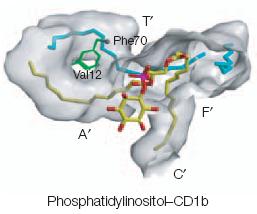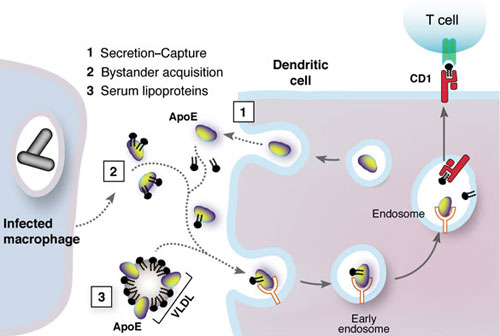Over view
Cell surface antigens CD1 A through E are expressed by professional antigen-presenting cells (APCs) for the presentation of non-peptide antigens to T cells. That is, they serve analogous functions as the MHC genes but are specialized in capturing and presenting a whole different class of antigens.
The MHC molecules are a large family of proteins. Each is different in its specificicity of antigen-capture, and most are highly polymorphic between individuals (hence matching of MHC, a.k.a. HLA, genotypes are performed prior to organ transplantation).
The CD1 genes are rather different. They are much less polymorphic between individuals and each molecule (CD1a through CD1e) binds a diverse set of antigens. Several crystal structures of CD1-antigen binding have been solved. The CD1 genes have been found to contain deeply buried hydrophobic surfaces to bind lipid antigens while exposing carbohydrate- and peptide-moieties for interaction with T-cell receptors. An example of phophotidylinosiol in the CD1b pocket is shown here.
The CD1 genes show differences in structure and function (reviewed by Moody et al 2005, ibid):
- The antigen-binding grooves in CD1a function as a 'molecular ruler' that binds lipids with a defined alkyl chain length.
- CD1b proteins can bind antigens with a lipid component of variable length. Similiar to the ability of MHC II to bind peptides longer than its binding groove, CD1b lets long antigens to protrude through portals to the outside of the antigen groove.
de la Salle, Mariotti, Angenieux et al 2005
This article in Science showed that
mycobacterial antigens hexamannosylated phosphatidyl-myo-inositols (PIM6) stimulate CD1b-restricted T cells only after partial digestion of the oligomannose moiety by lysosomal a-mannosidase and that soluble CD1e is required for this processing.
Polymorphisms in the CD1 gene gamily
Coming back to the point about the CD1 genes being functionally non-polymorphic. As summarized by Profs Manfred Brigl and Michael B. Brenner in Annual Reviews of Immunology, the few polymorphisms that have been found so far are either silent, amino acid changes outside the antigen-binding groove, or have and no detectable differences in expression or antibody reactivity. The exceptions are two CD1e alleles, CD1E*01 andCD1E*02, which did affect antigen-binding, but so far no association has been found between carrying these alleles and susceptibility to mycobacterial infections.
In general, it is much more difficult to make negative inferences in science(e.g., no crows are white) than it is to make positive ones (e.g., lots of crows are black). we check the dbSNP database of single-nucleotide polymorphisms and find that there are 10 SNPs in CD1e, many of which are validated. I will not be surprised if one day an association is found linking some of these polymorphisms with autoimmune diseases or diseases of chronic inflammation.
Role in the immune system: immunity against Mycobacteria
deferred
CD1 gene family: role in disease
deferred
Lipid antigens and the delivery of dietary lipids: a convergence
In an Oct Nature article, researchers from Prof Michael B. Brenner's lab found that the immune system uses apolipoproteins to deliver lipid antigens to CD1. That is,
Apolipoprotein E mediates the presentation of serum-borne lipid antigens and can be secreted by APCs as a mechanism to survey the local environment to capture antigens or to transfer microbial lipids from infected cells to bystander APCs. Thus, the immune system has co-opted a component of lipid metabolism to develop immunological responses to lipid antigens
From Focus, the news magazine for Harvard Longwood Campus,
"This may change the way we look at activation of T cells in asthma,� said Dale Umetsu of Children�s Hospital Boston, whose work has implicated lipid-reactive T cells in asthma and allergy in both mice and humans.
Technorati Tags:
medicine / Immune system / lipid antigen / Apolipoprotein / ApoE / Asthma / Structural biology / Chronic inflammation / Computational biology







No comments:
Post a Comment